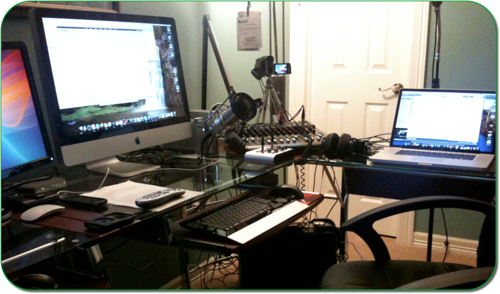Friday
May212010
Why I (Still) Love My 27” iMac
 Friday, May 21, 2010 at 3:18PM
Friday, May 21, 2010 at 3:18PM  The MacTexan LairAfter five months, my “BigMac” as I like to call it, is my favorite computer of all time. I get a little perturbed when tech magazines and blogs write reviews about machines just a couple of days after they’re released. I know in this fast-paced world of internet journalism there is huge pressure to be “the firstest with the mostest”. While I’ll admit to being anxious to read the first words written about Apple’s latest shiny, when it comes to making a serious decision about spending multiple thousands of dollars on a new computer, I prefer a more in-depth analysis than release day reviews can provide.
The MacTexan LairAfter five months, my “BigMac” as I like to call it, is my favorite computer of all time. I get a little perturbed when tech magazines and blogs write reviews about machines just a couple of days after they’re released. I know in this fast-paced world of internet journalism there is huge pressure to be “the firstest with the mostest”. While I’ll admit to being anxious to read the first words written about Apple’s latest shiny, when it comes to making a serious decision about spending multiple thousands of dollars on a new computer, I prefer a more in-depth analysis than release day reviews can provide.If you feel the same and are considering a new iMac then read on…
My new 27” Core i7 iMac arrived on the second week of December. The first thing I noticed was how minimal the packaging was. Before opening the box, I thought there was some mistake and I had gotten a 20.5”. After a closer inspection I was relieved to find I’d gotten exactly what I ordered:
- iMac 27” (11,1)
- Core i7 2.8 GHz
- 4 GB Ram
- 1 TB Hard Drive
Worried by all the horror stories about cracked displays and bent housings on the 27” models, I was relieved to see my new beauty was in perfect condition once I got it out of the tight packaging. The first thing I did after unwrapping the machine was install the additional 4 gigs of memory I’d purchased from MacSales.com. It was a snap to install and the activity saved me almost $90 compared to what Apple wanted for the same thing.
The next breath-holding event was the initial power-up. The other nightmare circulating around the interwebs was about the 27” displays having a yellow tint. Again, mine was perfect and has remained so. In fact, the 2560 X 1440 LED display is one of the best features of this machine. More on that later.
Performance
The Core i7 is more processor than 99% of users will ever need. The remaining 1% would have to be video editors or 3D graphic modelers. I use iStat Menus to display a trend for each of the 8 cores (4 physical and 4 virtual) and I am hard pressed to utilize 30% of the iMac’s CPU. I’ve only saturated all 8 cores when ripping a DVD using Handbrake and then only for 18 minutes while ripping a 6.7 GB movie. The same chore on my 3.06 GHz Core 2 Duo MacBook Pro takes 37 minutes. I routinely Flash encode three 320 X 240 video streams simultaneously. Doing so requires only 25% of the iMacs available horsepower. Unless your wagon is full of unencoded video, the Core i7 iMac has plenty of ponies to pull it.
The ATI 4850 GPU routinely runs Quake 3D set at 1900 X 1200 at over 90 frames per second. I’m no hardcore gamer, but I’m a Mac guy. Are any of us? Running Windows 7 through VMWare Fusion 3 yields a performance rating of 5.9 on the video parameter and Aero works beautifully with all the snaz turned on.
Aesthetics
The two main differences between this new iMac and the previous version is the edge-to-edge monitor glass and the all-aluminum back. When the monitor is turned off, the face of the machine is solid black with a three inch aluminum strip along the bottom containing the centered black glass Apple logo. Gone is the thin aluminum frame around the monitor. Even when off or sleeping, this is the most polished looking iMac to date. The solid aluminum back housing contains a larger Apple logo near the top center fashioned with the same black glass as the one on the front. This all aluminum treatment gives this newest Mac the same solid look as Apple’s laptops and the new iPad. Make no mistake, this 27” model is big. The wireless bluetooth keyboard and “Magic Mouse” that come standard look almost out of place with this rather large machine. Be prepared to make a little extra desktop space if you plan to buy one of these.
Display
This new 27” LED-backlit display makes the loss of desktop space well worth it. At a native resolution of 2560 X 1440, this monster is the most beautiful display I’ve ever used. As I mentioned earlier, I’ve not experienced any of the publicized problems that made such a big news splash when this machine was originally released. I ordered mine within the first week of availability so my machine was part of the problematic production run. Quite the contrary; I have been and continue to be completely awestruck by this display. It is fast, accurate and the pixel density is such that every window, icon and font looks completely solid with no pixelation or jagged edges any human can detect without a magnifying glass. This display is also the real value proposition of this Mac, especially when compared to a Mac Pro.
Value
This machine set me back roughly $2300 including the 4 GB of extra RAM I purchased separately from OtherWorldComputing.com. Because of all the Flash video encoding I do, I strongly considered a Mac Pro. An entry-level, quad-core Pro configured similarly with a 24” display costs $3650, and this iMac’s benchmarks are better! You can add a grand to that if you go with the 30” display. I know the iMac is not easily upgradable, but aside from that the decision was a slam dunk. For $1350 less than the 24” (1920 X 1200) Mac Pro, this iMac has better performance and a vastly superior display.
I never considered a PC for many reasons but mainly because I already own several Apple Pro software titles (Logic Studio, Aperture, Final Cut Express) and replicating their functionality on Windows would cost over $1000. Besides, I’m a Mac guy thru-and-thru. If you were to replicate this iMac’s hardware specs, a Dell XPS 8100 is the lowest cost PC to include the Core i7 and similar guts to the iMac. Equipped with a 27” Dell Ultrasharp display, this machine will set you back around $1975. Apple tax? No matter what you call it, Macs are always more expensive than equivalent PCs (if there is such a thing as an equivalent PC), but the differential is not as much as is often ballyhooed.
After five months, I (still) LOVE THIS MAC! I would recommend it to anyone wanting an ultimate Apple experience.



Reader Comments